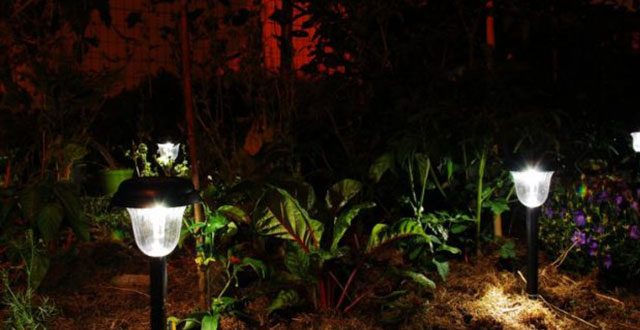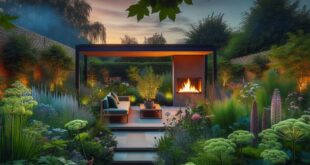Garden Lighting allows you to enjoy your garden after dark and to provide an attractive outlook from your house when you are comfortable and warm. It decorates an area for entertaining in the summer months and keep it looking alive during dark, wintry days when night time creeps in early. Solar and low voltage systems are easy to install yourself.
Outdoor illumination is not only appropriate for security and safety issues, but it creates ambience.
Planning Garden Lighting
Time spent planning your lighting scheme will enhance your garden’s best features.
- Visit local garden centres, DIY chains, electrical wholesalers and look at websites for inspiration.
- Concentrate on the most attractive features, such as a specific plant or water feature, don’t just light everything in sight.
- Think practically – light up steps and paths for safe access and combine with security lights.
- There are various control options; timers, light sensors, simple wall mounted switches or remote controls.
- Avoid positioning lights so that they shine onto a neighbour’s window.
- Some outdoor lights can get hot, so place out of reach of small children.
- Check your electrician is qualified and registered.
Solar, Mains or Low Voltage
Solar lighting has improved by leaps and bounds and with the advantage of no running costs. The simplest devices have integrated solar panels so there is no wiring, you simply position them. Use them as a feature in their own right, their low light output is insufficient to light objects. More powerful devices use a separate solar panel, for maximum effectiveness, they require full sun. The better units are bright enough to light garden features but the purchase cost is higher and there are “ugly” panels on view.
Mains powered devices are the most powerful, now using LED technology, running costs are low. Cabling requires professional installation ideally during garden construction. The heavier cabling is more difficult to hide.
Low Voltage devices now use LED lamps. Cable is lighter so easier to disguise. Water resistant boxes are readily available for housing transformers. Main cabling to the transformer or outdoor socket(s) requires professional installation.
Or, Naked Flames
Restaurants use candles or oil lamps for good reason, they help to create an ambience seemingly impossible with electricity. Candles or oil lamps using Citronella also provide a pleasant lemon like scent and can help to repel mosquitos.
Safety, has to be a concern if using naked flames. Make sure lamps are situated well away from anything that can catch fire including overhanging plants. Make sure stakes are secure in the ground. Never leave lighted candles or torches unattended.
Lighting Effects
There are a number of ways to create accent lighting or to add beauty to an evening landscape with the variety of lighting options available. Here are the key styles you can achieve when designing your garden lighting system and the important points to consider;
Pathway Lighting
Low level lights to illuminate paths. It certainly has an aesthetic appeal, but its basic function is to provide safety.
Security Lighting
Placed lamps strategically to eliminate dark spots. Although this type of lighting can serve to accent special features, its primary purpose is to provide safety and security.
Area Lighting
Lighting of a broad area, rather than spot or accent lighting.
Spot Lighting
Spot lighting draws attention to a specific feature such as a garden statue.
Mood Lighting
Offers a number of different techniques to create certain ambience in the landscape or around your home. Sophisticated system allow moods to change.
Moon Lighting
This technique places lights high in the trees to wash over a large area, giving the appearance of a full moon all month long.
Shadow Lighting
Create shadow effects from trees, sculptures and other garden features.
Silhouette Lighting
Light from behind highlights the bones or shape of the structure. Silhouette lighting is ideal to feature the architectural detail of a structure.
Water Lighting
This effect looks good, and if you have fish, they’ll turn into colourful streaks of light; however it doesn’t provide much functional light.
Down Lighting
If against a wall, down lighting can accent the texture while providing additional safety and security. Create a dramatic effect by accentuating the interesting branch structure of tall trees especially in winter when the trees are void of leaves.
Up Lighting
Lights at the bottom of a structure or tree and aimed upward to create an interesting focal point.
Rules and Regulations
(This is a guide only, consult a professional for the latest information).
To reduce the number of accidents caused by faulty electrical work, rules were tightened in 2005. All electrical work in the garden must now be carried out in accordance with Building Regulations.
- Should you be able to carry out work yourself, inspect and test that it is safe for use. To comply with the law you must notify your local building control office before starting any work and pay the appropriate fee for it to be inspected.
- NICEIC is the electrical contracting industry’s independent voluntary body for electrical installation matters throughout the UK. NICEIC maintains a list of around 20,000 approved electrical contractors and domestic installers. Find one in your area by calling 0870 013 0382 or visiting the NICEIC website.
- All outdoor sockets must be RCD protected for safety. An RCD or residual current device works by switching off the flow of electricity when a cable or flex is cut and should be hardwired to your fuse box.
- Cables for fixed outdoor lighting installations must be buried at a sufficient depth to avoid damage from garden tools and should also be protected by an earthed metallic cover. This will require the electrician to dig a trench in the garden.
- Always buy good quality outdoor lighting equipment from a reputable retailer and make sure the light fittings are weatherproof and replace any which are damaged. Approved quality light fitting should always carry an IP rating, which indicates how well it stands up to external conditions. Don’t forget to look for the BEAB Approved Mark or the European Community (CE) safety symbol too.
Installation and Maintenance
- Where possible lay piping or conduit for cables to pass underneath any hard landscaping. Your electrician will advise what to do if hard landscaping has already been laid.
- Take in decorative lights and transformer boxes after use unless they are specified as waterproof and designed to stay out all year round.
As with everything electrical, if in doubt, consult an expert
Place all cables and transformers out of sight to ensure the lighting scheme is only apparent when lit at night. Besides the aesthetic benefits, lighting a dark space is one of the most important deterrents to keeping potential burglars and vandals away, illuminating potentially dangerous areas for visiting family and friends and overall, making your property safe and secure.
 Gardeners Club The Gardeners Club is a free to join online club for everyone with an interest in gardening and gardens.
Gardeners Club The Gardeners Club is a free to join online club for everyone with an interest in gardening and gardens.






